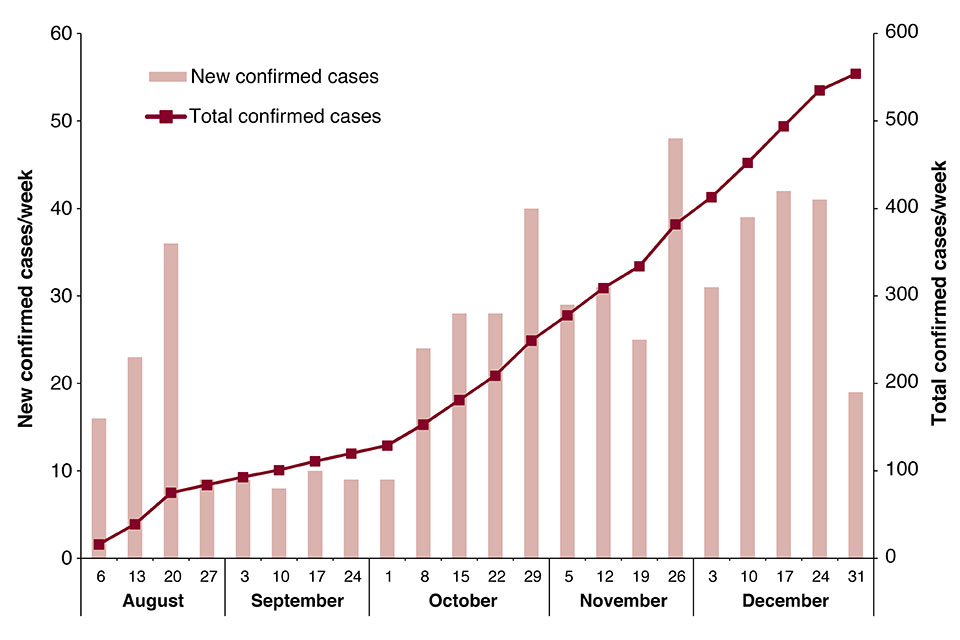HPR volume 13 issue 1: news (4 January)
Updated 20 December 2019
EVD outbreak in eastern DRC: fifth update
The outbreak of Ebola virus disease in eastern Democratic Republic of the Congo (DRC) continues unabated more than five months after the first case was officially confirmed in August 2018.
As of 31 December 2018, 560 confirmed cases and 48 probable cases have been reported in North Kivu and Ituri provinces [1]. The apparent decline in newly confirmed cases reported in the week ending 31 December (see figure) should be interpreted with caution. Between 27 and 29 December, significant disturbances to surveillance and response activities were reported predominantly in the major urban centres of Béni and Butembo. These were a result of community protests to a decision to prevent these cities voting in the national presidential election [2,3].
The disturbances affected contact tracing activities, laboratory testing and investigation of suspected cases and may be responsible for the apparent decline in case numbers in the last week [4]. Although the majority of response activities have since resumed, even short disturbances to response activities can result in increased transmission as has been demonstrated previously in this outbreak. The situation will be monitored very closely in the coming weeks.

New and total confirmed cases by week. Data provided by DRC Ministry of Health [1]
A shift in epicentres of this outbreak has been noted since late October and November. A concerted effort by DRC government, international partners and the local communities has resulted in the substantial reduction of incidence in Béni, a major urban area in North Kivu. However, in recent weeks Katwa, Komanda and Oicha have emerged as new epicentres for transmission. This raises two issues of concern; firstly concurrent multifaceted chains of transmission across a wide geographical area have a major effect on resources. Secondly, affected areas in Komanda and Oicha Health Zones are high security-risk and accessing villages with cases is difficult, which makes implementing a thorough and timely response in these areas problematic.
A high proportion of new cases (>60%) continue to be reported in individuals either not identified as contacts of confirmed cases or known contacts not under active monitoring at the time of symptom onset or diagnosis – indicating persistent issues with contact identification and monitoring.
The risk to the UK public remains very low to negligible. The situation is being monitored closely and the risk assessment is regularly reviewed.
Further information sources
- PHE website Ebola collection Ebola virus disease: clinical management and guidance
- NaTHNaC website for travel advice Travel Health Pro website
- WHO website EVD homepage Ebola virus disease
- FCO website DRC advice
References
-
DRC Ministry of Health daily updates (in French).
-
DRC Ministry of Health update 28 December 2018 (in French).
HPR subscriber satisfaction survey
To inform improvements in the Health Protection Report, we invite readers and subscribers to complete this survey.
Infection report in this issue
This issue includes:
